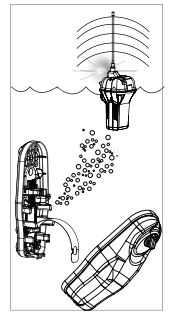When you’re out at sea, for business or pleasure, you should ensure that in any eventuality you can always be found safe and well.
With an EPIRB or Emergency Position Indicating Radio Beacon you can ensure this wherever you are in the world as a means of notifying Search and Rescue forces of where you are if you happen to be in any distress or require help and assistance.
Providing location data through either GPS, or triangulation, an EPIRB transmits distress signals that contain a 15 digit identification number unique to your boat or vessel to a government run system called Cospas-Sarsat Satellite System. This is then pulled up by Search and Rescue teams who pull up your EPIRB registration details, registered at the point of sale which can provide your emergency contact information.
Enabling rescue from your location, an EPIRB provides positional data to the Rescue Coordination Centre closest to your vessel to allow Search and Rescue teams to find you and bring you back safely with their own EPIRBs 121.5 MHz homing signal used to find your location.
With the odds of successful rescue much higher with an EPIRB due to the knowledge of your exact location, understanding the ones available is key to choosing the right one for your requirements, boat and purpose.

EPIRB categories
There are two types of EPIRB those which have the option to be automatically or manually deployed and those which are only deployed manually.
These are categorised by category I and category II beacons. The first model has a mounting bracket which features a hydrostatic release unit which only deploys the EPIRB, to make it float on the water’s surface, when it is submerged in water of a depth of more than 14 feet. Doing this automatically the beacon then transmits its signal autonomously at a frequency of 406 MHz.
The second type, the Category II can only operated through manual deployment and operation, although this allows them to be mounted above or below deck. You may opt to keep yours in a special bag without a bracket, but this is only effective when kept in a dry area of your vessel.
EPIRB categories
There are two types of EPIRB those which have the option to be automatically or manually deployed and those which are only deployed manually.
These are categorised by category I and category II beacons. The first model has a mounting bracket which features a hydrostatic release unit which only deploys the EPIRB, to make it float on the water’s surface, when it is submerged in water of a depth of more than 14 feet. Doing this automatically the beacon then transmits its signal autonomously at a frequency of 406 MHz.
The second type, the Category II can only operated through manual deployment and operation, although this allows them to be mounted above or below deck. You may opt to keep yours in a special bag without a bracket, but this is only effective when kept in a dry area of your vessel.
GPS EPIRBs
Owning an EPIRB that is integrated with GPS can enhance the area to which you can be located reducing it from two square miles to within just 300 feet reducing the average time of being located by rescuers from 90 minutes to just five.
Using two different satellites, GEOSAR and LEOSAR, the Cospas-Sarsat satellite system uses the GPS coordinates from your beacon to instantly alter Search and Rescue Teams to find your position as quickly as possible.
EPIRBS can either be fitted with a GPS interface or internal GPS.
You are required by law to register your EPIRB with your local authority upon purchase and update all information should you change address or vessel. Make sure you register it personally otherwise you could be contacted by authorities if it is activated.
To view our full range of EPIRBs or find out more, click here.


























Follow us